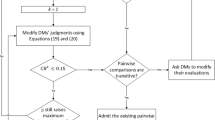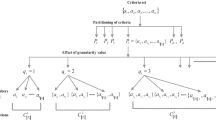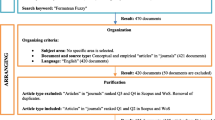Abstract
Hesitant fuzzy set (HFS) is more flexible and general tool in comparison to fuzzy set theory. There is not yet reported an aggregation operator (AO) which can provide desirable generality, flexibility and compatibility in adjusting risk preferences while aggregating attribute values under hesitant fuzzy (HF) environment, although based on algebraic t-norm and t-conorm, Einstein t-norm and t-conorm, Hammacher t-norm and t-conorm, Dombi t-norm and t-conorm and Frank t-norm and t-conorm; weighted AOs have been developed earlier to attempt to meet above such eventualities. So, the primary objective of this paper is to develop some general, flexible as well as compatible AOs that can be exploited to solve MADM problems with HF information. From this perspective, at the very beginning, we develop new operations between HFEs by uniting the features of Archimedean and Dombi operations. Next, based on these operations, we develop HF Archimedean-Dombi weighted arithmetic and geometric AOs, HF Archimedean-Dombi ordered weighted arithmetic and geometric AOs and HF Archimedean-Dombi hybrid arithmetic and geometric AOs. We have shown that the existing HF-algebraic weighted AOs, HF-Einstein weighted AOs and HF-Hammacher weighted AOs are special cases of our developed AOs. We discuss in detail some intriguing properties of the proposed AOs. Next, we establish a procedure of MADM endowed by the proposed operators under HF environment. Then, we present a practical example concerning the personnel selection to gloss the decision steps of the proposed method. We also conduct a validity test to show that our proposed AOs are authentic and legal. Moreover, we exhibit a sensitivity investigation with diverse criteria weight sets to examine the stability of our proposed intriguing approach. Also, we draw attention toward a comparison between the existing decision-making methods with the proposed method to prove the superiority of our model.

Similar content being viewed by others
References
Torra V (2010) Hesitant fuzzy sets. Int J Intell Syst 25:529–539
Torra V, Narukawa Y (2009) On hesitant fuzzy sets and decision. In: The 18th IEEE international conference on fuzzy systems; August 20–24, Ueju Island, Korea, pp 1378–1382
Xu Z, Xia M (2011) Distance and similarity measures for hesitant fuzzy sets. Inf Sci 18:2128–2138
Qian G, Wang H, Feng X (2013) Generalized hesitant fuzzy sets and their application in decision support system. Knowl Based Syst 37:357–365
Zhang N, Wei G (2013) Extension of VIKOR method for decision making problem based on hesitant fuzzy set. Appl Math Modell 37:4938–4947
Xu Z, Zhang X (2013) Hesitant fuzzy multi-attribute decision making based on TOPSIS with incomplete weight information. Knowl Based Syst 52:53–64
Zhang X, Xu Z (2014) The TODIM analysis approach based on novel measured functions under hesitant fuzzy environment. Knowl Based Syst 61:48–58
Chen N, Xu Z (2015) Hesitant fuzzy ELECTRE II approach: a new way to handle multi-criteria decision making problems. Inf Sci 292:175–197
Wang JQ, Wang J, Chen QH, Zhang HY, Chen XH (2014) An outranking approach for multi-criteria decision-making with hesitant fuzzy linguistic term sets. Inf Sci 280:338–351
Wang J, Wang JQ, Zhang HY, Chen XH (2015) Multi-criteria decision-making based on hesitant fuzzy linguistic term sets: an outranking approach. Knowl Based Syst 86:224–236
Zhang X, Xu Z (2014) Interval programming method for hesitant fuzzy multi-attribute group decision making with incomplete preference over alternatives. Comput Indus Eng 75:217–229
Zhu B, Xu Z, Xu J (2014) Deriving a ranking from hesitant fuzzy preference relations under group decision making. IEEE Trans Cybern 44:1328–1337
Zhang X, Xu Z (2015) Hesitant fuzzy agglomerative hierarchical clustering algorithms. Int J Syst Sci 46:562–576
Ye J (2014) Correlation coefficient of dual hesitant fuzzy sets and its application to multiple attribute decision making. Appl Math Modell 38:659–666
Liao H, Xu Z, Zeng XJ (2015) Novel correlation coefficients between hesitant fuzzy sets and their application in decision making. Knowl Based Syst 82:115–127
Liu H, Rodríguez RM (2014) A fuzzy envelope for hesitant fuzzy linguistic term set and its application to multi-criteria decision making. Inf Sci 258:220–238
Zhao N, Xu Z, Liu F (2015) Uncertainty measures for hesitant fuzzy information. Int J Intell Syst 30:818–836
Rodríguez R, Martínez L, Torra V, Xu Z, Herrera F (2014) Hesitant fuzzy sets: state of the art and future directions. Int J Intell Syst 29:495–524
Xu Z (2014) Hesitant fuzzy sets theory. Springer, Berlin
Xia M, Xu Z (2011) Hesitant fuzzy information aggregation in decision making. Int J Approx Reason 52:395–407
Xia M, Xu Z, Chen N (2013) Some hesitant fuzzy aggregation operators with their application in group decision making. Group Decis Negotiat 22:259–279
Wei G (2012) Hesitant fuzzy prioritized operators and their application to multiple attribute decision making. Knowl Based Syst 31:176–182
Wei G, Zhao X, Wang H, Lin R (2012) Hesitant fuzzy Choquet integral aggregation operators and their applications to multiple attribute decision making. Int Inf Inst (Tokyo) Inf 15:441–448
Zhu B, Xu Z, Xia M (2012) Hesitant fuzzy geometric Bonferroni means. Inf Sci 205:72–85
Zhang Z (2013) Hesitant fuzzy power aggregation operators and their application to multiple attribute group decision making. Inf Sci 234:150–181
Zhang Z, Wu C (2014) Weighted hesitant fuzzy sets and their application to multi-criteria decision making. Br J Math Comput Sci 4:1091–1123
Liao H, Xu Z (2015) Extended hesitant fuzzy hybrid weighted aggregation operators and their application in decision making. Soft Comput: 1–14
Yu D (2014) Some hesitant fuzzy information aggregation operators based on Einstein operational laws. Int J Intell Syst 29:320–340
Tan C, Yi W, Chen X (2015) Hesitant fuzzy Hamacher aggregation operators for multi-criteria decision making. Appl Soft Comput 26:325–349
Qin J, Liu X, Pedrycz W (2015) Hesitant fuzzy maclaurin symmetric mean operators and its application to multiple-attribute decision making. Int J Fuzzy Syst 17:509–520
Qin J, Liu X, Pedrycz W (2015) Frank aggregation operators and their applications to hesitant fuzzy multiple attribute decision making. Appl Soft Comput. https://doi.org/10.1016/j.asoc.2015.12.030
He X (2017) Typhoon disaster assessment based on Dombi hesitant fuzzy information aggregation operators. Nat Hazard. https://doi.org/10.1007/s11069-017-3091-0
Wang Y, Zhang R, Quian L (2018) An improved A* algorithm based on hesitant fuzzy set theory for multi criteria acrtic route planning. Symmet. https://doi.org/10.3390/sym10120765
Liao H, Si G, Xu Z, Fujita H (2018) Hesitant fuzzy linguistic preference utility set and its application in selection of fire rescue plans. Int J Envi Res Publ Health. https://doi.org/10.3390/ijerph15040664
Liu XD, Wang ZW, Zhang ST, Liu JS (2019) A novel approach to fuzzy cognitive map based on hesitant fuzzy sets for modeling risk impact on electric power system. Int J Comput Intell Syst 12:842–854
Liu X, Wang Z, Zhang S, Liu J (2020) Probabilistic hesitant fuzzy multiple attribute decision making based on regret theory for the evaluation of venture capital projects. Econom Res 33:672–697
Mishra AR, Rani P, Pardasani KR, Mardani A (2019) A novel hesitant fuzzy WASPAS method for assessment of green supplier problem based on exponential information measures. J Clean Prod. https://doi.org/10.1016/j.jclepro.2019.117901
Dombi J (1982) A general class of fuzzy operators, the De Morgan class of fuzzy operators and fuzziness measures induced by fuzzy operators. Fuzz Sets Syst 8:149–163
Klir G, Yuan B (1995) Fuzzy sets and fuzzy logic: theory and applications. Prentice Hall, Upper Saddle River
Nguyen HT, Walker EA (1997) A first course in fuzzy logic. CRC Press, Boca Raton
Klement EP, Mesiar R (2005) Logical, algebraic, analytic and probabilistic aspects of triangular norms. Elsevier, New York
Boran FE, Genc S, Akay D (2011) Personnel selection based on intuitionistic fuzzy sets. Human Fac Ergono Manufac Serv Ind 21:493–503
Wang X, Triantaphyllou E (2008) Ranking irregularities when evaluating alternatives by using some ELECTRE methods. Int J Manag Sci 36:45–63
Kirkwood CW (1997) Strategic decision making: Multi-Objective decision analysis with spreadsheets. Duxbury Press, Belmont
Kahraman YR (2002) Robust sensitivity analysis for multi-attribute deterministic hierarchical value models (No. AFIT/GOR/ENS/02-10). Air Force Inst of Tech Wright-PATTERSONAFB OH
Author information
Authors and Affiliations
Corresponding author
Ethics declarations
Conflict of interest
The authors declare that they have no conflict of interest.
Additional information
Publisher's Note
Springer Nature remains neutral with regard to jurisdictional claims in published maps and institutional affiliations.
Appendices
Appendix 1: list of abbreviations
Abbreviation | Full name |
|---|---|
HFS | Hesitant fuzzy set |
HFE | Hesitant fuzzy element |
HF | Hesitant fuzzy |
AO | Aggregation operator |
MADM | Multi-attribute decision making |
HFADWAA | Hesitant fuzzy Archimedean–Dombi weighted arithmetic aggregation operator |
HFADOWAA | Hesitant fuzzy Archimedean–Dombi ordered weighted arithmetic aggregation operator |
HFADHAA | Hesitant fuzzy Archimedean–Dombi hybrid arithmetic aggregation operator |
HFADWGA | Hesitant fuzzy Archimedean–Dombi weighted geometric aggregation operator |
HFADOWGA | Hesitant fuzzy Archimedean–Dombi ordered weighted geometric aggregation operator |
HFADHGA | Hesitant fuzzy Archimedean–Dombi hybrid geometric aggregation operator |
HFWA | Hesitant fuzzy weighted arithmetic aggregation operator |
HFWG | Hesitant fuzzy weighted geometric aggregation operator |
HFFWA | Hesitant fuzzy Frank weighted averaging operator |
HFFWG | Hesitant fuzzy Frank weighted geometric operator |
HFHWA | Hesitant fuzzy Hamachar weighted arithmetic aggregation operator |
HFHWG | Hesitant fuzzy Hamachar weighted geometric aggregation operator |
HFHOWA | Hesitant fuzzy Hamachar ordered weighted arithmetic aggregation operator |
HFHOWG | Hesitant fuzzy Hamachar ordered weighted geometric aggregation operator |
HFDWA | Hesitant fuzzy Dombi weighted arithmetic aggregation operator |
HFDWG | Hesitant fuzzy Dombi weighted geometric aggregation operator |
HFDOWA | Hesitant fuzzy Dombi ordered weighted arithmetic aggregation operator |
HFDOWG | Hesitant fuzzy Dombi ordered weighted geometric aggregation operator |
HFEWA | Hesitant fuzzy Einstein weighted arithmetic aggregation operator |
HFEWG | Hesitant fuzzy Einstein weighted geometric aggregation operator |
HFEOWA | Hesitant fuzzy Einstein ordered weighted arithmetic aggregation operator |
HFEOWG | Hesitant fuzzy Einstein ordered weighted geometric aggregation operator |
Appendix 2: hesitant fuzzy sets
Definition 8
[1] Let U be a finite universe of discourse. Then a hesitant fuzzy set \( \xi \) on U is defined as:
where \( \mu_{\xi }^{h} :U \to 2^{[0,1]} \) is a mapping, and \( \mu_{\xi }^{h} (x) \) denotes the set (finite) of possible membership degrees of the element \( x \in U \).
Given \( x \in U \), \( \mu_{\xi }^{h} \) is termed as a hesitant fuzzy element (HFE) [20]. For sake of simplicity, the hesitant fuzzy set \( \xi \) is represented by \( \left\langle {\mu_{\xi }^{h} } \right\rangle \). The set of all HFEs on U is denoted by \( {\text{HFE}}^{U} \).
Definition 9
[20] For two HFEs \( \mu_{{\xi_{1} }}^{h} \,\,{\text{and}}\,\,\,\mu_{{\xi_{2} }}^{h} \) on U, some basic operations between them can be described as:
-
(1)
\( \mu_{{\xi_{1} }}^{h} \cup \,\mu_{{\xi_{2} }}^{h} = \mathop \cup \limits_{{\alpha_{1} \in \mu_{{\xi_{1} }}^{h} ,\alpha_{2} \in \mu_{{\xi_{2} }}^{h} }} max\{ \alpha_{1} ,\alpha_{2} \} \)
-
(2)
\( \mu_{{\xi_{1} }}^{h} \cap \,\mu_{{\xi_{2} }}^{h} = \mathop \cup \limits_{{\alpha_{1} \in \mu_{{\xi_{1} }}^{h} ,\alpha_{2} \in \mu_{{\xi_{2} }}^{h} }} min\{ \alpha_{1} ,\alpha_{2} \} \)
-
(3)
\( \left( {\mu_{{\xi_{1} }}^{h} } \right)^{c} = \mathop \cup \limits_{{\alpha_{1} \in \mu_{{\xi_{1} }}^{h} }} \{ 1 - \alpha_{1} \} \)
-
(4)
\( \mu_{{\xi_{1} }}^{h} \oplus \,\mu_{{\xi_{2} }}^{h} = \mathop \cup \limits_{{\alpha_{1} \in \mu_{{\xi_{1} }}^{h} ,\alpha_{2} \in \mu_{{\xi_{2} }}^{h} }} \{ \alpha_{1} + \alpha_{2} - \alpha_{1} \alpha_{2} \} \)
-
(5)
\( \mu_{{\xi_{1} }}^{h} \otimes \,\mu_{{\xi_{2} }}^{h} = \mathop \cup \limits_{{\alpha_{1} \in \mu_{{\xi_{1} }}^{h} ,\alpha_{2} \in \mu_{{\xi_{2} }}^{h} }} \{ \alpha_{1} \alpha_{2} \} \)
-
(6)
\( \lambda \mu_{{\xi_{1} }}^{h} = \mathop \cup \limits_{{\alpha_{1} \in \mu_{{\xi_{1} }}^{h} }} \{ 1 - (1 - \alpha_{1} )^{\lambda } \} \,\,\,\,\,\,(\lambda > 0) \)
-
(7)
\( \left( {\mu_{{\xi_{1} }}^{h} } \right)^{\lambda } = \mathop \cup \limits_{{\alpha_{1} \in \mu_{{\xi_{1} }}^{h} }} \{ (\alpha_{1} )^{\lambda } \} \,\,\,\,\,\,(\lambda > 0) \)
Theorem 24
[20] Let \( \mu_{{\xi_{1} }}^{h} \,\,{\text{and}}\,\,\,\mu_{{\xi_{2} }}^{h} \) be two HFEs defined on U and \( \lambda ,\lambda_{1} ,\,\lambda_{2} > 0 \). Then
-
(i)
\( \mu_{{\xi_{1} }}^{h} \oplus \mu_{{\xi_{2} }}^{h} = \mu_{{\xi_{2} }}^{h} \oplus \mu_{{\xi_{1} }}^{h} \)
-
(ii)
\( \mu_{{\xi_{1} }}^{h} \otimes \mu_{{\xi_{2} }}^{h} = \mu_{{\xi_{2} }}^{h} \otimes \mu_{{\xi_{1} }}^{h} \)
-
(iii)
\( \lambda (\mu_{{\xi_{1} }}^{h} \oplus \mu_{{\xi_{2} }}^{h} ) = (\lambda \mu_{{\xi_{1} }}^{h} ) \oplus (\lambda \mu_{{\xi_{2} }}^{h} ) \)
-
(iv)
\( (\mu_{{\xi_{1} }}^{h} \otimes \mu_{{\xi_{2} }}^{h} )^{\lambda } = (\mu_{{\xi_{1} }}^{h} )^{\lambda } \otimes (\mu_{{\xi_{2} }}^{h} )^{\lambda } \)
-
(v)
\( (\lambda_{1} + \,\lambda_{2} )\mu_{{\xi_{1} }}^{h} = (\lambda_{1} \mu_{{\xi_{1} }}^{h} ) \oplus (\lambda_{2} \mu_{{\xi_{1} }}^{h} ) \)
-
(vi)
\( (\mu_{{\xi_{1} }}^{h} )^{{\lambda_{1} + \,\lambda_{2} }} = (\mu_{{\xi_{1} }}^{h} )^{{\lambda_{1} }} \otimes (\mu_{{\xi_{1} }}^{h} )^{{\lambda_{2} }} \)
Definition 10
[20] Let \( \mu_{\xi }^{h} \) be a HFE on U. Then the score value of \( \mu_{\xi }^{h} \) is defined as:
where \( \# \mu_{\xi }^{h} \) denotes the number of elements in \( \mu_{\xi }^{h} \).
Based on the score values of HFEs, a comparison method of HFEs is described below:
Definition 11
[20] Suppose \( \mu_{{\xi_{1} }}^{h} \,\,{\text{and}}\,\,\,\mu_{{\xi_{2} }}^{h} \) be two HFEs on U. Then
-
(1)
If \( S(\mu_{{\xi_{1} }}^{h} \,) > S(\mu_{{\xi_{2} }}^{h} ) \), then \( \mu_{{\xi_{1} }}^{h} \succ \,\mu_{{\xi_{2} }}^{h} \)
-
(2)
If \( S(\mu_{{\xi_{1} }}^{h} \,) < S(\mu_{{\xi_{2} }}^{h} ) \), then \( \mu_{{\xi_{1} }}^{h} \prec \,\mu_{{\xi_{2} }}^{h} \)
-
(3)
If \( S(\mu_{{\xi_{1} }}^{h} \,) = S(\mu_{{\xi_{2} }}^{h} ) \), then \( \mu_{{\xi_{1} }}^{h} = \,\mu_{{\xi_{2} }}^{h} \)
Appendix 3: Archimedean t-norm and t-conorm
Definition 12
[39, 40] A fuzzy t-norm \( f:[0,1] \times [0,1] \to [0,1] \) is a function which satisfies the following axioms:
-
(i)
\( f(x,1) = x\,\,{\text{for}}\,\,x \in [0,1] \)
-
(ii)
\( f(x,y) \le f(x^{\prime},y^{\prime})\,\,provided\,\,\,x \le x^{\prime},\,y \le y^{\prime}\,\,{\text{for}}\,\,x,x^{\prime},\,y,y^{\prime} \in [0,1] \)
-
(iii)
\( f(x,y) = f(y,x)\,\,{\text{for}}\,\,\,x,\,y, \in [0,1] \)
-
(iv)
\( f(x,f(y,z)) = f(f(x,y),z)\,\,{\text{for}}\,\,\,x,\,y, \in [0,1] \)
Definition 13
[39, 40] A fuzzy t-conorm \( g:[0,1] \times [0,1] \to [0,1] \) is a function which satisfies the following axioms:
-
(i)
\( g(x,0) = x\,\,{\text{for}}\,\,x \in [0,1] \)
-
(ii)
\( g(x,y) \le g(x^{\prime},y^{\prime})\,\,provided\,\,\,x \le x^{\prime},\,y \le y^{\prime}\,\,{\text{for}}\,\,x,x^{\prime},\,y,y^{\prime} \in [0,1] \)
-
(iii)
\( g(x,y) = g(y,x)\,\,{\text{for}}\,\,\,x,\,y, \in [0,1] \)
-
(iv)
\( g(x,g(y,z)) = g(g(x,y),z)\,\,{\text{for}}\,\,\,x,\,y, \in [0,1] \)
Definition 14
[39, 40] A t-norm function \( f(x,y) \) is called a strictly Archimedean t-norm if it is continuous, \( f(x,x) < x\,\,\,\forall \,x \in (0,1) \) and strictly increasing for \( x,y \in (0,1). \)
Definition 15
[39, 40] A t-conorm function \( g(x,y) \) is called a strictly Archimedean t-conorm if it is continuous, \( g(x,x) > x\,\,\,\forall \,x \in (0,1) \) and strictly increasing for \( x,y \in (0,1) \).
Definition 16
[41] Suppose \( \theta :(0,1] \to R \) is a continuous function such that \( \theta \) is strictly decreasing. Then a strictly Archimedean t-norm is expressed by:
Definition 17
[41] Suppose \( \psi :[0,1) \to R \) is a continuous function such that \( \psi (l) = \theta (1 - l),\,l \in [0,1) \), and \( \psi \) is strictly increasing. Then a strictly Archimedean t-conorm is expressed by:
Appendix 4: Dombi operations
The operations of t-norm and t-conorm, developed by Dombi [38] are generally known as Dombi operations described below:
Definition 18
[38] For any two real numbers x and y in [0, 1], the Dombi t-norm and Dombi t-conorm can be defined as follows:
Dombi operations have good precedence of change w.r.t values of the parameter ‘k’. Based on the Dombi operations, He [32] developed a few operations between HFEs given below:
Definition 19
[32] Let \( \mu_{{\xi_{1} }}^{h} \,\,{\text{and}}\,\,\,\mu_{{\xi_{2} }}^{h} \) be two HFEs on U.
-
(i)
\( \mu_{{\xi_{1} }}^{h} \oplus_{D} \mu_{{\xi_{2} }}^{h} = \mathop \cup \limits_{{\alpha_{1} \in \mu_{{\xi_{1} }}^{h} ,\,\,\alpha_{2} \in \mu_{{\xi_{2} }}^{h} }} \left\{ {1 - \left( {1 + \left\{ {\left( {\frac{{\alpha_{1} }}{{1 - \alpha_{1} }}} \right)^{k} + \left( {\frac{{\alpha_{2} }}{{1 - \alpha_{2} }}} \right)^{k} } \right\}^{{\frac{1}{k}}} } \right)^{ - 1} } \right\} \)
-
(ii)
\( \mu_{{\xi_{1} }}^{h} \otimes_{D} \mu_{{\xi_{2} }}^{h} = \mathop \cup \limits_{{\alpha_{1} \in \mu_{{\xi_{1} }}^{h} ,\,\,\alpha_{2} \in \mu_{{\xi_{2} }}^{h} }} \left\{ {\left( {1 + \left\{ {\left( {\frac{{1 - \alpha_{1} }}{{\alpha_{1} }}} \right)^{k} + \left( {\frac{{1 - \alpha_{2} }}{{\alpha_{2} }}} \right)^{k} } \right\}^{{\frac{1}{k}}} } \right)^{ - 1} } \right\} \)
-
(iii)
\( \lambda *_{D} \mu_{{\xi_{1} }}^{h} = \mathop \cup \limits_{{\alpha_{1} \in \mu_{{\xi_{1} }}^{h} }} \left\{ {1 - \left( {1 + \left\{ {\lambda \left( {\frac{{\alpha_{1} }}{{1 - \alpha_{1} }}} \right)^{k} } \right\}^{{\frac{1}{k}}} } \right)^{ - 1} } \right\}\,\,\,\,\,\,\,(\lambda > 0) \)
-
(iv)
\( \lambda \circ_{D} \mu_{{\xi_{1} }}^{h} = \mathop \cup \limits_{{\alpha_{1} \in \mu_{{\xi_{1} }}^{h} }} \left\{ {\left( {1 + \left\{ {\lambda \left( {\frac{{1 - \alpha_{1} }}{{\alpha_{1} }}} \right)^{k} } \right\}^{{\frac{1}{k}}} } \right)^{ - 1} } \right\}\,\,\,\,\,\,\,(\lambda > 0) \)
Rights and permissions
About this article
Cite this article
Saha, A., Dutta, D. & Kar, S. Some new hybrid hesitant fuzzy weighted aggregation operators based on Archimedean and Dombi operations for multi-attribute decision making. Neural Comput & Applic 33, 8753–8776 (2021). https://doi.org/10.1007/s00521-020-05623-x
Received:
Accepted:
Published:
Issue Date:
DOI: https://doi.org/10.1007/s00521-020-05623-x




